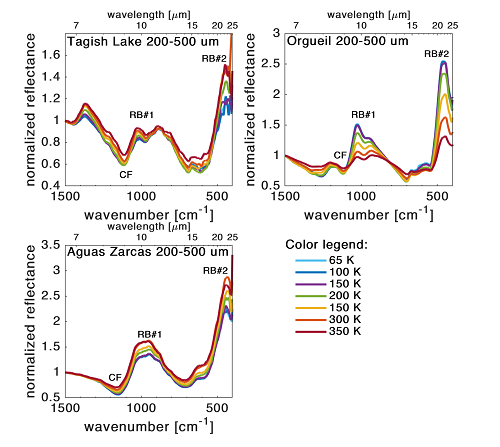Temperature dependent mid-infrared (5-25 μm) reflectance spectroscopy of carbonaceous meteorites and minerals: implication for remote sensing in Solar System exploration.
- 1Department of Physics and Astronomy, University of Florence, Firenze, Italy
- 2INAF – Astrophysical Observatory of Arcetri, Firenze, Italy
- 3INAF – Astronomical Observatory of Roma, Roma, Italy
- 4LESIA, Observatoire de Paris, Université PSL, CNRS, Université de Paris, Sorbonne Université, Meudon, France
- 5INAF – Astronomical Observatory of Padova, Padova, Italy
Interpretation of spectroscopic data from remote sensing strongly depends on the spectroscopic properties, particle size and temperature of materials on the observed surface. Spectral indices of silicates, carbonates, sulfates, oxides and chemicals available on public database are commonly obtained at room temperature and pressure. Whether temperature can affect spectral properties of minerals such as the peak position, band area and shape, was advanced decades ago (Singer & Roush, 1985), but a systematic laboratory study on such effects is still missing. Hitherto, few studies were performed analyzing the effects of space environment, such as low pressure and temperature, on spectroscopic features of minerals, mostly focusing on near infrared spectral region (Moroz, et al. 2000; Hinrichs & Lucey 2002; De Angelis, et al. 2019). This is especially lacking in the mid-infrared region, where laboratory data are almost completely absent. Thus, it is pivotal to acquire spectra in vacuum at various temperatures and varying the particle sizes, for better simulating space environmental conditions.
Our apparatus at INAF-Astrophysical Observatory of Arcetri allows reflectance measurements in an extended spectral range from VIS to far IR and at temperatures ranging from 64 K to 500 K. We present here a detailed analysis on temperature-dependent variation on mineral and carbonaceous chondrite samples in the spectral range 1500-400 cm-1 (6.6-25 µm in wavelength). Mineral phases and meteorites analyzed are: pyroxene, olivine, serpentine, Tagish Lake (CI2-ungruped), Aguas Zarcas (CM2) and Orgueil (CI1). Samples are prepared with particle sizes <20 μm, <200 μm, and 200-500 μm. Our results show that temperature induces spectral features modifications such as peak position shifts, band area and peak intensity changes (Fig 1). Modifications are reversible with temperature and the trend of variation is related to the sample composition and hydration level. Moreover, magnitude of temperature-dependent spectroscopic changes is strongly linked with grain size and composition, hence making this type of analysis pivotal for a correct interpretation of data collected by space telescopes and orbital spacecrafts.

Figure 1 Meteorite spectra at different temperature normalized at 1500 cm-1 in wavenumber range between 1500 cm-1 and 400 cm-1. Tagish Lake (top left panel), Orgueil (top right panel) and Aguas Zarcas (bottom left panel). All samples are sieved in grain size 200-500 µm. Spectra were acquired at different temperature step from 65 K (light blue) to 350 K (red). Position of Christiansen features (CF) and Reststrahlen bands (RB) are highlighted.
References
De Angelis, S., et al. 2019. Icarus, 317, 388-411
Hinrichs, J. L. & Lucey, P. G., 2002. Icarus, 155, 169-180
Moroz, L., Schade, U. & Wash, R., 2000. Icarus, 147, 79-93.
Singer, R. B. & Roush, T. L., 1985. Journal of Geophysical Research, 90 (B14), 12434-12444.
How to cite: Poggiali, G., Brucato, J. R., Dotto, E., Ieva, S., Barucci, M. A., Pajola, M., Fornaro, T., Corazzi, M. A., Meneghin, A., and Paglialunga, D.: Temperature dependent mid-infrared (5-25 μm) reflectance spectroscopy of carbonaceous meteorites and minerals: implication for remote sensing in Solar System exploration., Europlanet Science Congress 2020, online, 21 September–9 Oct 2020, EPSC2020-568, https://doi.org/10.5194/epsc2020-568, 2020

